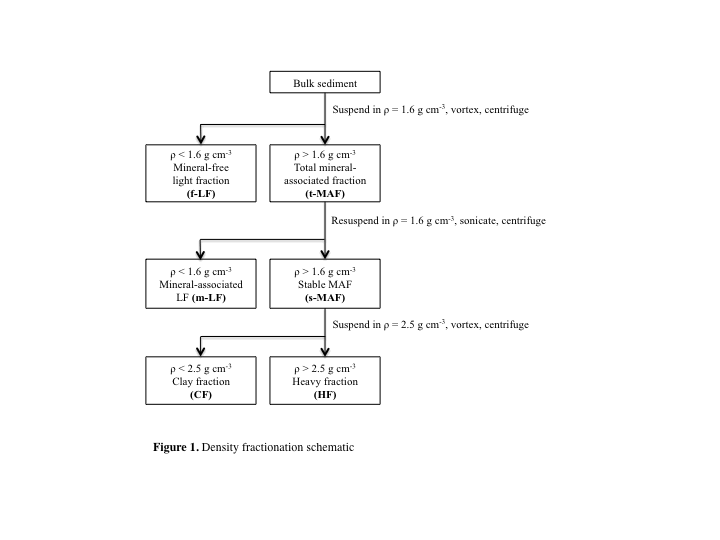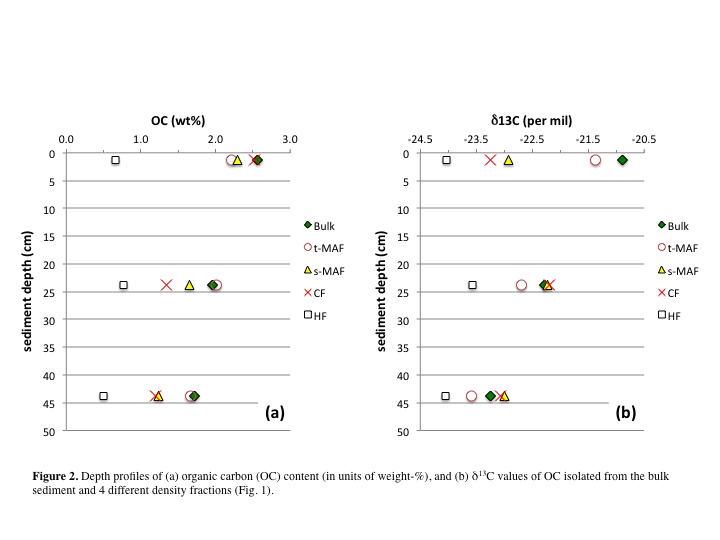Reports: UR256968-UR2: Stabilization of Organic Carbon in Salt Marsh Sediments: A Physical Protection Perspective
Tomoko Komada, San Francisco State University
Overview and introduction
Salt marshes are globally significant repositories of organic carbon (OC), and have received attention as potential locales where anthropogenic CO2 could be sequestered through marsh production and accretion. However, unlike organogenic (peaty) marshes that only receive OC input from local production, minerogenic marshes receive OC from both autochthonous and allochthnous sources, complicating the relationship between local CO2 fixation and OC burial. Therefore, our project addresses the following questions: What is the relative importance of autochthonous and allochthonous OC buried in minerogenic salt marsh sediments, and what are their likelihoods for preservation during burial?
To help distinguish allochthonous OC from autochthonous OC, we: (1) separate bulk sedimentary OC according to density; and (2) examine OC dynamics in areas dominated by C4 production. Density fractionation allows gross separation of low-density organic detritus (dominated by autochthonous OC) from mineral associated OC (assumed 100% allochthonous at time of deposition). Conducting the work in zones under C4 macrophyte cover (in this case Spartina foliosa) allows use of d13C signatures as tracers for autochthonous from allochthonous OC (predominantly C3).
Work completed to date
We have set up a detailed density fractionation method that allows physical isolation of 6 density fractions from the whole sediment (Fig. 1). This scheme was applied to sediment samples collected from the Spartina zone adjacent to Gallinas Creek, San Francisco Estuary. Sediment cores were collected using a Russian peat borer, sectioned into 2.5-cm intervals, then gently passed through a 2-mm mesh prior to density separation.
To date, we have obtained OC and d13C values of the OC for the bulk and mineral-associated fractions (t-MAF, S-MAF, CF and HF) recovered from the core top (0.0-2.5 cm), mid-depth (22.5-25.0 cm) and the deepest horizon (42.5-45.0 cm). The low-density fractions (f-LF and m-LF) have been collected, but have not yet been analyzed.
Based on the marsh accretion rate reported for this region of the estuary (0.4 cm yr-1; Callaway et al. Est. Coasts 2012, 35,1163-1181), the samples analyzed to date are ~5, 60, and 110 years old (for core-top, mid-depth, and deep, respectively). According to EcoAtlas, California Wetlands Monitoring Workgroup, this site was a mudflat prior to colonization by Spartina. While we currently do not have an exact timing of the colonization, it is likely that this occurred sometime after 1850. Therefore, in our discussion below, we will assume that the deepest sample was deposited either under mudflat conditions, or shortly after Spartina colonization, whereas the mid-depth sample was deposited under solid Spartina cover.
Results to date
Complete mass and OC yields are not yet available, because the low-density fractions (f-LF and m-LF in Fig. 1) have not yet been analyzed. However, based on preliminary data, CF is the dominant contributor to both the total sediment mass and the total OC pool. HF contributed considerably less in terms of both sediment mass and OC.
Fig. 2a shows depth profiles of OC content of the density separates, and of the bulk sample. With the exception of HF that did not change appreciably with depth, the OC content of all other fractions and the bulk sample declined with depth, particularly between the core-top and mid-depth samples. Assuming that OC input rate has remained steady, this decline is consistent with OC loss due to diagenesis. The muted variability in the OC content of HF suggests slow turnover of OC in this fraction.
Fig. 2b shows depth profiles of d13C signatures of OC in the density separates, and in the bulk sample. At all three depth horizons, HF displayed the lowest d13C values with very little depth variability. Combined with its near constant OC content (Fig. 2a), we surmise that OC in HF is predominantly allochthonous at all depths, and biogeochemically stable.
At the core-top, the d13C values of bulk sample and t-MAF were ~2 per mil enriched compared to CF and HF (Fig. 2b). Because the difference between t-MAF and s-MAF is m-LF (Fig. 1), this separation in isotopic value is interpreted to indicate the occurrence of C4-derived low-density OC within the t-MAF (and bulk sample) matrix. The steady decline in d13C values of the bulk sample and t-MAF with depth would then point to continued loss of C4-derived OC relative to C3-OC in these fractions during burial.
In contrast to the bulk sample and t-MAF, the d13C values of s-MAF and CF initially increased from the core-top to mid-depth, then decreased to the bottom sample (Fig. 2b). We interpret the initial increase to indicate incorporation of C4-derived OC into these fractions over 60 years of diagenesis under Spartina cover. The decline in d13C values below this depth is more difficult to interpret, because the exact timing of Spartina colonization is not known. However, the fact that the d13C values of s-MAF, CF and HF at depth are very similar to those at the core-top suggests that regardless of land cover, the OC composition of these mineral-associated fractions are likely similar to allochthonous OC being delivered to this site today.
If we tentatively assign -23.2 per mil and -15.0 per mil for allochthonous OC and Spartina biomass, respectively, the above results indicate that ~10% of the OC in CF originated from Spartina in the mid-depth sample. If we interpret the ~0.5 per mil enrichment in HF at mid-depth relative to core-top and bottom in a similar fashion (and using -24.0 per mil as the allochthonous OC signature), at mid-depth, ~5% of OC in HF is Spartina-derived.
Preliminary conclusions
Results to date show input of autochthonous OC to the surface sediments primarily in the form of low-density material, followed by loss of this OC pool during burial. However, there is also evidence for incorporation (and hence stabilization) of some autochthonous OC into the mineral-associated pool during burial. Degree of autochthonous OC incorporation appears greater for CF (~10%) than HF (~5%). Because there is overall loss of OC from all pools with increasing depth, this incorporation of autochthonous OC suggests some level of replacement of allochthonous OC with locally-produced OC.













